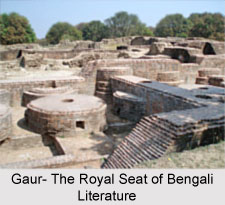 The Nawabs of Bengal gave great encouragement to the writers which led to further Development of Bengali literature during Muslim Rule. The writers wrote on Persian themes. This led introduction of several Persian words as well as themes into Literature of Bengal. Shek Subhodaya, a Sanskrit hagiology on Shaykh Dialal al-Din Tabrizi and Niranjaner Rushma, a Bengali ballad by Ramai Pandit indicates the influence of Islamic rule. Sultans of Hussain Shahi Bengal encouraged the development of Bengali literature that is read by both Hindu and Muslim. The Sultans of Pandua and Gaud extended their support to Bengali literature irrespective of caste.
The Nawabs of Bengal gave great encouragement to the writers which led to further Development of Bengali literature during Muslim Rule. The writers wrote on Persian themes. This led introduction of several Persian words as well as themes into Literature of Bengal. Shek Subhodaya, a Sanskrit hagiology on Shaykh Dialal al-Din Tabrizi and Niranjaner Rushma, a Bengali ballad by Ramai Pandit indicates the influence of Islamic rule. Sultans of Hussain Shahi Bengal encouraged the development of Bengali literature that is read by both Hindu and Muslim. The Sultans of Pandua and Gaud extended their support to Bengali literature irrespective of caste.
The Bhagavata, Ramayana and Mahabharata were translated into Bengali during their rule. Poets like Vidyapati and Chandidas flourished during this period. Several literary themes were derived from Perso-Arabic culture. Saint-poet Nur Kutb-i Alam of Pandua, introduced the Rikhta Style in Bengali. In this style half the hemstitch was composed in Persian and the other half in Bengali. Muhammad Saghir is the author of the first Bengali romance YusufZulaykha. Other romantic writers were Bahram Khan (Layla Madjnun), Sabirid khan (Hanifa-Kayrapari), Donaghazi(Sayf al-Mulk) and Muhammad Kabir(Madhumalati).
The Muslim writers replaced the invocations to Hindu gods and goddesses by
Hamd and Nat. This was a steady practice of all Muslim writers. The important romantic writers were Shah Muhammad Saghir; Daulat Uzir Bahram Khan; Daululat Qazi of Arakan, Alaol(Padmavati)Saiful Mulk Badiuzzamal, Haft Paikar and Sikander Nama; Abdul Hakim (Yusuf -Zuleikah) Querishi Magan( Mrigavati)
Dobhashi literature was used by Muslim writers. In order to develop Bengali nomenclature Muslim writers were being habituated with this practice from early days. However these writings have some features in common like the humanistic love story.
Heroic tradition include Zainuddin`s `Rasul Vijay`, Shah Barid`s `Rasul Vijay` and `Hanifer Digvijay`, Muhammad Khan`s Hanifar Ladai, Gharibullah`s Janganama, Heyat Mohammad`s Jangnama and Syed Hamza`s Amir Hamza. It was substituted in the narratives by a growing practice of escapism, fairy tales, romance and fantastic adventures. This was known as Dobhashi literature.
Elegiac literature developed centering the tragedy of Karbala. It depicts the life and history of the prophet from the creation till the death of the grandson of the Prophet, Imam Hussain at Karbala. The most important works are: Navivangsha of Sayyid Sultan, Maktul Hussain of Mohammad Khan, Maktul Hussain of Muhammad Yaqub and Janganama of Abdul Hakim. One of the major features of this poem was lamentation and the freedom with which the imagination of the poets roams freely and describes the lamentation of trees, skies, the earth, the angels and departed souls.
The medieval age was the period of Muslim cultural development. Sayyid Sultan`s Navibangsha, Shab-iMiraj, Ofat-i-Rasul and Muhammad Khan`s Maqtul Hussain and Kiyamatnama speak of the Muslim concept of origin, evolution and destruction of the Earth and the final judgement of good and bad souls. It was an attempt to inform the ignorant about purifying of souls. Other important works are: Neeti-Shahstravasta of Muzammil, Neseehatnama of Afzal Ali, Shariatnama of Nasrullah Khan
In mystic literary practice there are two categories. It includes the tradition of philosophical expositions of the theory and practices of religion as well as the Padavalis. Baul and Murshidi were also popular songs. Through symbols different stages of s disciple till the final stage of self illumination are described. Most of the
Murshidi songs are found in Bengal. This is followed by the thematic expressions of the Mathnavi of Maulana Jalal Uddin Rumi and of the Mantiq- ut- Taier of Shaikh Fariduddin Attar.



















